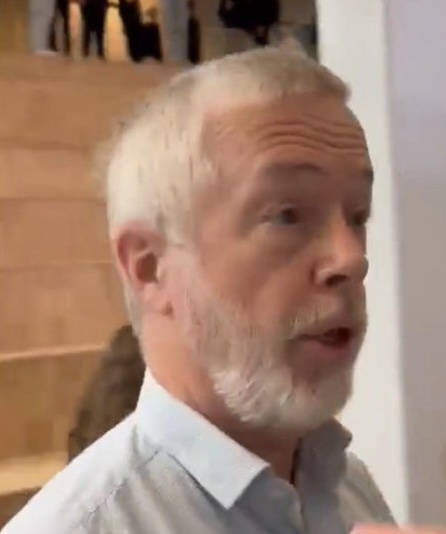

Woman Of The Year 2023
Norsklærer Arild Noven fra Os er årets kjærring. Vi gratulerer!

Lærer Arild Noven ved Åsane videregående skole er Taliban Norges Woman of the year 2023
foto: Patrik Johnsen
5. september 2023
Ingar Holst
Eight facts about the two official Norwegian languages Bokmål and Nynorsk
One fact which is generally not reflected upon, not among Norwegians and not even among linguists, is that the two main official written forms of Norwegians, Bokmål and Nynorsk, by law taught in the compulsory education system, used in broadcasting and media, and in all governmental and local public administration, are both constructed languages. More precisely, they are (fact 1) a posteriori constructed controlled auxiliary languages, based on two different proportions of mixing on the one hand various Norwegian dialects and on the other hand Riksmål Norwegian, the only natural Norwegian language with a recognized written standard and a rich corpus of literature.
Do you like meatballs and potatoes with tiramisu and coffee for dessert? Bokmål and Nynorsk are meatballs, potatoes, tiramisu and coffee blended together in a mixmaster and served. You have no say over the blend ratio and you have to finish what lands on your plate. If you have ever wondered why Norwegians tend to express themselves poorly, it is for the same reason why most people do not choose to learn Esperanto over Italian, even if Esperanto is much simpler and much more regular: (fact 2) Bokmål or Nynorsk is nobody’s mother tongue. I recommend going to YouTube and listen to oratory leprechauns like the NATO Secretary General Jens Stoltenberg, the explorer Thor Heyerdahl, or any Norwegian industrial or political leader as illustrations of to what degree Norwegians are generally inept at expressing themselves.
While there is a standardized way of pronouncing Riksmål Norwegian, nobody speaks Bokmål or Nynorsk (fact 3). Norwegians will speak their local dialect and then make more or less successful attempts of adhering to the ever shifting grammatical and orthographic rules of either Bokmål or Nynorsk.
While it has over time dawned upon the educational authorities that deciding spelling and grammar of a nation’s official language by taking a vote in political assemblies is not conducive to public literacy, as opposed to guiding students to discover and adhere to the conventions that may be deduced from published literature, what is correct spelling and grammar of Bokmål and Nynorsk is decided by committees appointed by the Norwegian parliament (fact 4). When Bokmål changed from a German way of counting (one and twenty, two and twenty) to an English way of counting (twenty one, twenty two), this decision was even made by a vote in the parliament itself in 1950.
This was in no way a one-off accident. A parliamentary appointed committee has later in its wisdom changed the spelling of expressions like “1/3” and “1/5” from the previous “one third part” (en tredjedel) and “one fifth part” (en femtedel) to become “one three part” (en tredel) and “one five part” (en femdel).
Why? Because it was thought to be simpler and easier. Bokmål is simplified Eastern Norwegian and Nynorsk is simplified Western Norwegian (fact 5). The proper Eastern Norwegian language is for all practical purposes Riksmål Norwegian. Riksmål is my mother tongue, which we spoke at home, and which my mother and her parents spoke and wrote.
Alterations to the spelling and grammar of Norwegian is a frequent occurrence (fact 6). When I went to school, The Caspian Sea was called “Det kaspiske hav”. Nowadays it is supposed to be “Kaspihavet”. When my parents went to school, France was spelled “Frankrige”, now it is spelled “Frankrike”. When my grandparents went to school, the country Turkey was spelled “Tyrkiet”, and now it is spelled “Tyrkia” (they changed the friggin grammatical gender of the country from neuter to feminine).
During the decade I spent at the University of Oslo, I commuted on a subway line that was variously called the Sognsvann Line, the Sognsvatn Line and the Soknsvatn Line. The name changed back and forth four times during those ten years according to whether the Conservatives or Labor sat at the helm in the Oslo city council. They did this to annoy each other. The first generation Pakistanis who habitually chauffeured the subway cars never stood a chance of announcing the line name correctly, and oh yes, they changed the name of the stations too whenever and wherever they could. A Labor city council once removed one i in “Riis” station, which is situated in a strongly conservative-leaning constituency. The affronted outcries from the mostly elderly electorate in that constituency did not fail to materialize, and an octogenarian in a letter to the editor threaten to emigrate if the station did not get its former name back.
To add insult to injury, if you work in the public sector and do not keep up with the current spelling, you violate the terms of employment and may be fired (fact 7). I know this from personal experience after having worked a brief one year stint in the Royal Ministry of Education in the 1980s.
Still not confused? Generations of Norwegians have embraced Sir Alec Issigonis’ saying: “A camel is a horse designed by a committee”. The two official written norms of Norwegian are camels, not horses (fact 8). They get their points across slowly, dryly, and you do get a sore ass. This is why Norwegians tend to choose the desert route when embarking upon any sizable project (recent public scandals include a new railroad line and a new hospital data system) and tend to drink barrels when finally reaching a waterhole (check out how downtown Oslo turns into a naval battle every Saturday evening).